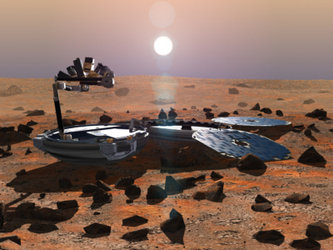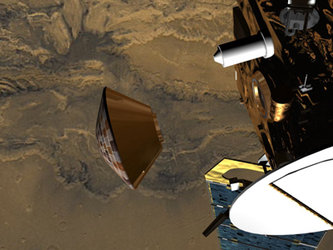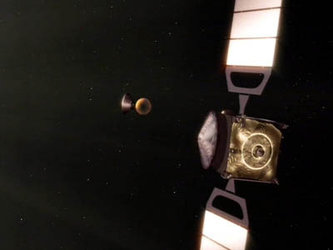Voyages to Mars
Some space scientists refer a ‘Mars Demon’, an imaginary force which sabotages spacecraft destined for the Red Planet!
In reality there are no demons but, despite being one of Earth’s closest planetary neighbours, and possibly the most similar physically, Mars still is in fact a tough place to visit.
There have been almost forty attempted missions to Mars – with more than half of those ending in failure. The spacecraft that have worked have revealed a world of wonder with tantalising similarities and exotic differences to our own.
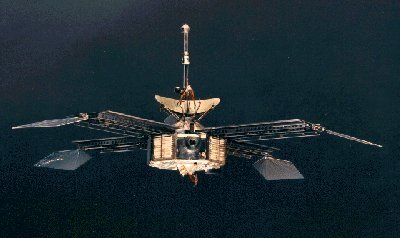
The first successful mission to Mars, Mariner 4, was launched by NASA on 28 November 1964. It passed within 9000 kilometres of Mars on July 14, 1965, returning 22 pictures as planned, the first close-up photographs of another planet.
The pictures, played back from a small tape recorder over a long period, showed lunar-type impact craters, dispelling the long-held myth of canals and lost civilisations on Mars.

Mariner 8 and 9 were the third and final pair of Mars missions in NASA's Mariner series. Both were designed to be the first Mars orbiters, moving on from flying by the planet to spending time around it.
Unfortunately, Mariner 8 failed during launch, but Mariner 9 became the first artificial satellite of Mars when it arrived and went into orbit, where it functioned for nearly a year.
The Soviet Union's twin Mars 2 and 3 spacecraft were launched in May 1971. Mars 2 arrived and entered orbit and released a lander, but this crashed on the surface after its breaking rockets failed - although it did become the first man-made object on Mars.
Its sister ship, Mars 3, also orbited Mars and dropped a lander successfully onto the surface. It worked for 20 seconds and experts suspect that it was destroyed by a Martian dust storm.
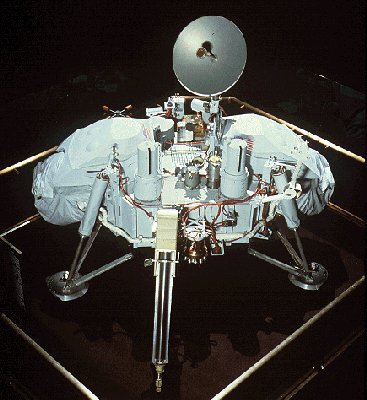
The space missions that put Mars exploration on the map, however, were undoubtedly the twin Viking missions of the mid 1970s. Both consisted of an orbiter and a lander, with the landers returning the first detailed pictures from the Martian surface.
The Viking landers showed a desert-like landscape that, in temperature, was actually more like the tundra of Earth. The orbiters mapped 97% of the planet.

Further Martian exploration then languished for over two decades, punctuated by nothing but a few failed or partially successful attempts. The Soviet Phobos 1 orbiter/lander was lost en route to Mars in 1989, and Phobos 2, was also lost in the same year near the Martian moon Phobos. The US Mars Observer was lost just before Mars arrival in 1993.
Mars Global Surveyor became the first successful mission to the Red Planet in twenty years when it was launched in 1996, entering orbit in 1997.

In the same year, NASA’s ‘faster, cheaper, better’ policy delivered Mars Pathfinder to the surface of the Red Planet. The tiny rover, Sojourner, crawled the surface for many weeks, analysing rocks and capturing the imagination of the general public.
Unfortunately that did not prove to be the beginning of a glorious renaissance and the ‘Mars Demon’ struck again, rendering the next four missions useless or severely damaged.
The Russian Mars ’96 orbiter and landers, carrying several European experiments, were lost in launch vehicle accident in 1996. The US Mars Climate Orbiter was lost on arrival at Mars in 1999. The US Mars Polar Lander/Deep Space 2 probes were also lost on arrival in 1999.
However, in 2001, the US Mars Odyssey successfully arrived in orbit carrying science experiments designed to make global observations of Mars, and this spacecraft will also serve as a communications relay for US and European spacecraft arriving at Mars in 2003 and 2004.
The year 2003, however, saw a resumed interest in Mars with a crescendo of Mars missions: ESA launched Mars Express with its Beagle lander, and NASA sent two rovers, Spirit and Opportunity. The Japanese Nozomi spacecraft was due to arrive in early 2004 but suffered a malfunction and, after valiant attempts by the mission team to recover the spacecraft, it was lost.
On Christmas Day 2003, ESA's Mars Express successfully arrived in orbit around Mars. In early January, the Beagle 2 lander had still not yet signalled its safe landing. On 4 January 2004, the first of NASA's rovers, Spirit, touched down on the surface. On 25 January, NASA's second rover, Opportunity also landed successfully.
By February 2004, Beagle 2 had failed to communicate since its first radio contact was missed after it was due to land on Christmas Day. The Beagle 2 Management Board met in London on Friday 6 February and, following an assessment of the situation, declared Beagle 2 lost.
ESA's Mars Express orbiter will be in orbit around the Red Planet, carrying out science operations and returning spectacular images, for many months to come.








